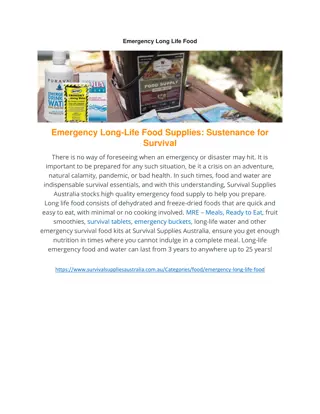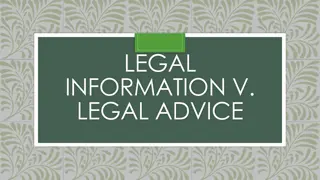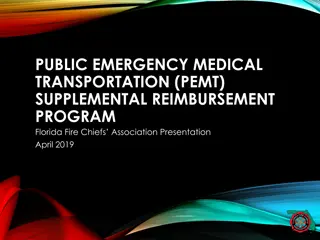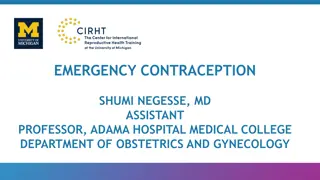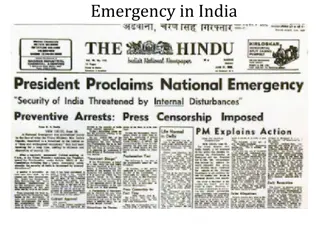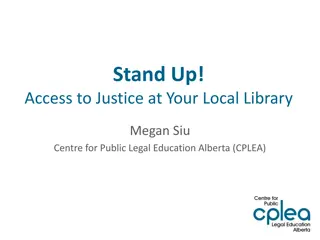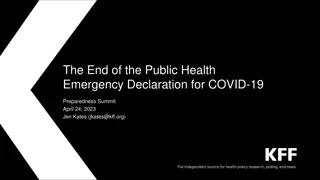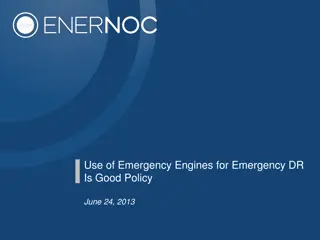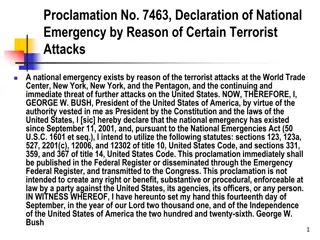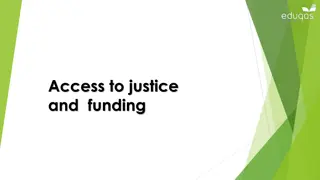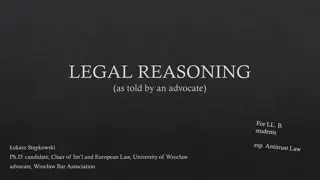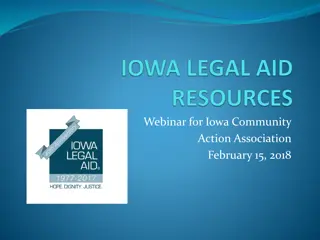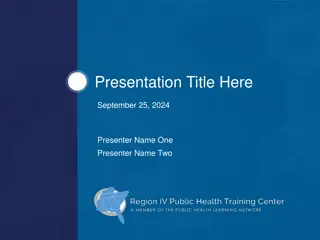Legal Repercussions of Public Health Emergency Rescissions on May 3, 2023
Discussion by legal experts including Lawrence Gostin and Lauren Dedon on key legal questions and lessons learned in supporting governors during a pandemic, focusing on gubernatorial emergency powers, COVID-19 litigation, and lessons for future emergencies. The session explores the legal landscape of public health emergencies, emphasizing the importance of legal frameworks in managing such crises and supporting effective governance.
Download Presentation

Please find below an Image/Link to download the presentation.
The content on the website is provided AS IS for your information and personal use only. It may not be sold, licensed, or shared on other websites without obtaining consent from the author.If you encounter any issues during the download, it is possible that the publisher has removed the file from their server.
You are allowed to download the files provided on this website for personal or commercial use, subject to the condition that they are used lawfully. All files are the property of their respective owners.
The content on the website is provided AS IS for your information and personal use only. It may not be sold, licensed, or shared on other websites without obtaining consent from the author.
E N D
Presentation Transcript
Legal Repercussions of Public Health Emergency Rescissions May 3, 2023
Moderator Summer Ghaith, J.D., M.D. (candidate) Mayo Clinic Alix School of Medicine; Sandra Day O Connor College of Law, ASU 2
Presenter Lawrence Gostin, J.D., LL.D, Founding O Neill Chair in Global Health Law; Faculty Director, O Neill Institute; Director, WHO Collaborating Center on Global Health Law 3
Presenter Lauren Dedon, J.D., Senior Legal Policy Advisor, National Governors Association 4
Presenter Erica N. White, J.D., Senior Attorney, Network for Public Health Law Western Region Office 5
Supporting Governors During a Pandemic: Key Legal Questions and Lessons Learned Lauren Dedon, Senior Legal Policy Advisor, National Governors Association
Agenda NGA Background Overview of Gubernatorial Emergency Powers State COVID-19 Landscape: Litigation & Legislation Legal Lessons Learned for Future Emergencies
Membership Member Services & Bringing Governors/Staff Together at Annual Meetings Partners Supporting Governors and Public/Private Relationships Center for Best Practices 501(c)(3) Sharing Research and Solutions for Governors on a Range of State Policy Issues Government Relations Representing Governors on the Hill and with Federal Partners
NGA Center for Best Practices Public Safety & Legal Counsel Public Health Cybersecurity K-12 Education Substance Use & Mental Health Children & Families Healthcare Delivery Infrastructure Workforce Development & Economic Policy Homeland Security Post-Secondary Education Energy Land Energy & Environment Management, Agriculture, and Wildlife
Agenda NGA Background Overview of Gubernatorial Emergency Powers StateCOVID-19 Landscape: Litigation & Legislation Legal Lessons Learned for Future Emergencies
Emergency Management From day one, Governors must be prepared for day-to-day events tornadoes, hurricanes, floods, power outages, fires,and hazardous materials spill as well as for catastrophes on the scale of the COVID-19 pandemic, Hurricane Katrina, or the September 11 terrorist attacks. It is crucial to understand the extent of the Governor s emergency powers and how to declare an emergency.
Gubernatorial Emergency Powers Declaring an Emergency Scope of Order Statutory authorities & types Durational limits Legislative involvement Federal/State/Tribal/Local Coordination Other Constraints Activate emergency response plans/mutual aid agreements Expend funds/deploy emergency personnel & resources Activate immunity/liability protections Suspend/waive state rules & regulations Streamline administrative procedures/procurement requirements Public health mitigation measures Other applicable response activities Order Contents Effective dates Conditions giving rise to the emergency Geographic areas covered Agency leading the response Applicable response actions
State/Territory COVID-19 Emergencies The COVID-19 response marked the first time in US history when all 55 governors of the states and territories issued some type of emergency declaration in response to the same incident. State 2020 Federal 3/13: Stafford Act Emergency 3/13: National Emergencies Act 3/20: Defense Production Act 2/4: HHS PREP Act Declaration 1/31: HHS PHE January February March 3/16: Every State/Territory has a Declared Emergency in Place 1/29: States/Territories Begin to Declare Emergencies
State COVID-19 Emergency Response Actions Health/Public Health Mitigation Temporary Physical Business Closures Contracts & Procurement Mutual Aid Agreements Isolation & Quarantine Stay at Home Orders Mask Requirements Operational Testing, Screening, Treatment Anti-Price Gouging Unlocking Funding Essential Business Designations Gathering & Capacity Limits Surveillance & Reporting Vaccine Mandates or Prohibitions Waiving Rules & Regs Resource Allocation Travel Restrictions Schools & Virtual Learning Standards of Care Emergency Response Plans & ICS Liability Protections & Immunities Licensing & Scope of Practice Remote/Virtual Flexibilities Open Meetings Telehealth Othe Eviction Moratoriums Unemployment Benefits Correctional Populations Food Programs r
Agenda NGA Background Overview of Gubernatorial Emergency Powers State COVID-19 Landscape: Litigation & Legislation Legal Lessons Learned for Future Emergencies
Governor-Involved COVID-19 Legal Challenges Emergency powers were used as the legal basis for many COVID-19 response efforts. Legal Challenges to gubernatorial actions were seen in litigation and legislation. Legislation Litigation Legislators in almost every state have introduced hundreds of bills to limit state executive authority to respond to COVID-19 or future public health emergencies. At least 400 lawsuits brought in 50 states and territories challenging executive actions taken by Governors and state officials in response to COVID-19.
Key Legal Challenges & Claims First Amendment (e.g., freedom of religion, speech, assembly/association) Scope of Social Distancing & Public Health Mitigation Measures Second Amendment (e.g., related to gun store closures) Emergency/Executive Authority Fifth Amendment (e.g., takings clause) Fourteenth Amendment (e.g., substantive and procedural due process, equal protection, interstate travel, privacy) Mask Mandates or Prohibitions Vaccine Mandates or Prohibitions Other Legal Claims Generally, State & Federal Courts Affirmed Governors Emergency Authorities
Journal of Emergency Management (JEM) Article ASTHO, CDC, NGA collaboration Highlights the New Legislative Landscape Discusses Enhancements and Restrictions Journal article: em/article/view/3394 https://wmpllc.org/ojs/index.php/j ASTHO legislative tracking: Sentinel Surveillance of Emerging Laws Limiting Public Health Emergency Orders
State Legislation Impacting Government Response Capabilities Restrictions Enhancements Oversight of Executive Actions Limits on Duration of Emergencies and Orders Limits on Scope of Emergency Powers and Public Health Orders oFirst and Second Amendment Rights oLimiting Measure for the Prevention and Control of Infectious Disease Increasing Vaccine Access and Supporting Vaccine Administration Strengthening public health investigation and enforcement authority for state agencies Preclusion of local orders by orders at the state level
Agenda NGA Background Overview of Gubernatorial Emergency Powers State COVID-19 Landscape: Litigation & Legislation Legal Lessons Learned for Future Emergencies
Legal Lessons Learned Develop Processes to Act Quickly Understand Your Tools All Hands on Deck Effort Communication Balancing Risks
Thank you! Lauren Dedon, JD Senior Legal Policy Advisor National Governors Association Ldedon@nga.org
Legal Repercussions of Public Health Emergency Rescissions Erica N. White, JD Senior Attorney Network for Public Health Law, Western Region Office May 3, 2023
Game Plan Federal Emergency Declarations Public Health Emergency (PHE) PREP Act FDA EUAs Stafford Act National Emergencies Act Defense Production Act Legal Landscape Post-PHE What is changing and what is staying the same 24
Emergencies Terminating? Source: https://www.nytimes.com/2023/01/30/us/politics/biden-covid-public-health- emergency.html Source: https://www.washingtonpost.com/business/2023/04/10/what-ending-us-covid- emergency-means-for-vaccines-tests-drugs/7ecdb278-d7f3-11ed-aebd- 3fd2ac4c460a_story.html 25
Emergencies Terminating? Source: https://www.politico.com/news/2023/01/31/house-end-covid-public-health- emergency-00080507 Source: https://thehill.com/policy/healthcare/3924782-senate-votes-to-end-covid-19- national-emergency/ Source: https://news.yahoo.com/biden-ends-covid-national-emergency- 012324101.html 26
Emergency Declarations WHO Public Health Emergency of Int l Concern January 30, 2020 Emergency Declarations by Foreign Governments Ongoing International HHS Public Health Emergency Stafford Act or National Emergencies Act Federal Emergency or Disaster Public Health Emergency State/Tribal Public Health Emergency Emergency or Disaster Local Source: https://www.networkforphl.org/wp- content/uploads/2021/03/Western-Region-Primer-COVID- 002.pdf 27
Federal Emergency Declarations (2020) HHS PREP Act Declar- ation National Emer- gencies Act Stafford Act Emergency Defense Production Act HHS Public Health Emergency Mar. 20 Mar. 13 Mar. 13 Jan. 31 Feb. 4 Source: https://www.networkforphl.org/wp- content/uploads/2021/03/Western-Region-Primer-COVID-002.pdf 28 28 28
Public Health Emergency (PHE) Jan. 31, 2020: HHS declares Public Health Emergency (PHE) pursuant to sec. 319 of the Public Health Service Act (PHSA), 42 U.S.C. 201 (2000). The PHE has been renewed every 90 days since, for a total of 1,196 days on May 11, 2023. The PHSA: Permits federal law waivers and flexibilities (e.g., CMS sec. 1135) Facilitates interjurisdictional coordination Supports medical countermeasures and social distancing 29
PHE Jan. 30, 2023: White House announces PHE will end on May 11, 2023. Feb. 9, 2023: HHS Secretary Becerra sends letter to governors announcing final renewal of PHE on Feb. 11, to end May 11, 2023. 30
Public Readiness and Emergency Preparedness (PREP) Act of 2005 Feb. 4, 2020: HHS Secretary issues PREP Act declaration pursuant to sec. 319F-3 of the Public Health Service Act of 2005. The PREP Act provides liability immunity for COVID-related health care activities (e.g., HCWs, facilities, countermeasures). 31
PREP Act April 14, 2023: HHS Secretary Becerra sends letter to governors confirming that the PREP Act declaration will extend past May 11. 32
FDA Emergency Use Authorizations (EUAs) Feb. 7, 2020: HHS Secretary issues a notice pursuant to sec. 564 of the Federal Food, Drug, & Cosmetic (FD&C) Act authorizing emergency use (EUA) of in vitro diagnostics for detection or diagnosis of COVID-19. EUAs require a pre-determined emergency (e.g., PHE) to authorize such countermeasures. Legally separate from PHE. 33
EUAs March 2023 FDA Guidance outlines phased transition plan for manufacturers, health care facilities and providers, and others. Phase 1: Implementation Date: May 11, 2023 Adverse reporting requirements to prepare for phase 3 Phase 2: 90 days after implementation date Corrections and removals or registration and listing requirements for manufacturers Phase 3: 180 days after implementation date FDA does not intend to object to continued distribution of devices within the scope of this guidance 34
Stafford Act & National Emergencies Act March 13, 2020: President Trump declares dual emergencies via the National Emergencies Act & 501(b) of the Stafford Act. The National Emergency may be terminated by a joint resolution of Congress or non-renewal. The national emergencies: Authorize FEMA Disaster Relief Fund access Allows federal reimbursement of eligible state response measures Permits federal law waivers and flexibilities (e.g., Medicare, Medicaid, CHIP, HIPAA) 35
National Emergencies Act April 10, 2023: President Biden signs H.J.Res. 7, immediately ending the national emergency declaration. 36
Defense Production Act of 1950 (DPA) March 20, 2020: President Trump invokes DPA to compel U.S. manufacturers to produce scarce materials and resources (e.g., ventilators, PPE). DPA authorizes the president to require private companies to accept and prioritize contracts for materials necessary for the national defense. Legally separate from PHE. 37
Game Plan Federal Emergency Declarations Public Health Emergency (PHE) PREP Act FDA EUAs Stafford Act National Emergencies Act Defense Production Act Legal Landscape Post-PHE What is changing and what is staying the same 38
PHE vs. National Emergency Source: https://www.nytimes.com/2023/01/30/us/politics/biden-covid-public-health- emergency.html Source: https://news.yahoo.com/biden-ends-covid-national-emergency- 012324101.html 39
COVID Vaccines What s Changing? Uninsured may have access and coverage issues. Plans no longer have to fully reimburse out-of-network vaccination (including administration fee) costs. What s Staying the Same? COVID-19 vaccine and booster availability and access are determined by the supply of federally-purchased vaccines. Under ACA preventive service requirements, COVID-19 vaccines must be covered at 100%. Medicaid & CHIP coverage no longer tied to PHE. COVID vaccination requirements for HCWs and others not tied to PHE. 40
COVID Tests What s Changing? Tests may not be covered at 100% by private health plans What s Staying the Same? Medicaid & CHIP coverage no longer tied to PHE. 41
Telehealth What s Changing? Telehealth was greatly expanded under the PHE but was severed by recent federal legislation. What s Staying the Same? Telehealth is no longer tied to the PHE under the Consolidated Appropriations Act of 2023; flexibilities will expire 151 days after end of PHE. Medicare beneficiaries Federally-qualified health centers Rural health clinics Medicaid & CHIP 42
HIPAA What s Changing? HHS HIPAA penalty waivers, everyday communications technologies usages, and DEA prescription services will end with PHE. What s Staying the Same? Some states made allowances for inter-state telemedicine, which may still be in place with state emergency declarations. 43
Medicare What s Changing? COVID vaccines & tests Hospitals no longer receive 20% increase in Medicare payment rate. Medicare Part D coverage no longer required to provide 90-day supply of covered drugs. What s Staying the Same? Under 2022 Medicare rules, out-of-network service coverage/parity requirements for Medicare Advantage plans end 30 days after last applicable federal or state emergency declaration. 44
Medicaid What s Changing? States lose abilities to adopt flexibilities and waivers. What s Staying the Same? Continuous enrollment is no longer tied to the PHE under the Consolidated Appropriations Act of 2023 and ended on March 31, 2023. 45
Private Health Insurance What s Changing? Out of network vaccines, testing, and treatment mayno longer be covered at 100%. Mental health parity requirements may be affected by employer coverage of COVID tests or other services. See March 29, 2023 DOL Guidance What s Staying the Same? PHE does not impact ability to continue to cover testing and treatment at 100% (pending future HHS guidance). First dollar coverage for telehealth services no longer tied to PHE per specific legislation (expanded to 2024; non- calendar plan years may be affected). 46
PREP Act What s Staying the Same? HHS confirmed on April 14, 2023 that the PREP Act will extend past May 11. 47
EUAs What s Staying the Same? Not effected by PHE termination. March 2023 FDA Guidance 48
DPA What s Staying the Same? DPA authorities tied to separate federal statute not legally tied to PHE. 49
What Else? Immigration? Title 42 Student loan forgiveness? HEROES Act of 2003 & SCOTUS 50



